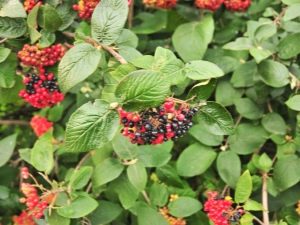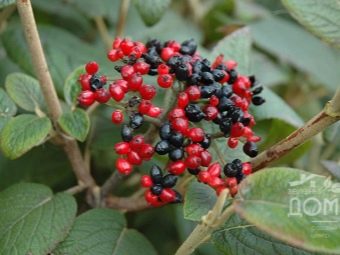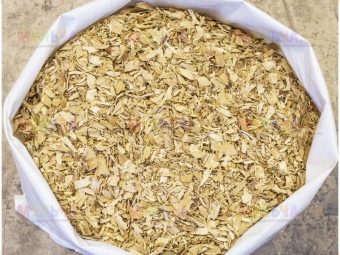Kalina "Gordovina": description and tips for growing

Each gardener loves to experiment on his own plot, come up with an interesting design, plant new crops. Many gardeners discovered a very beautiful bush Gordina viburnum.Description and tips on cultivation will help to understand why this shrub attracts gardeners.
Special features
Kalina "Gordovina" performs well as an ornamental shrub in urban areas and in private farmsteads. His description is very impressive. Thick crown is up to three meters in diameter, the branches are close to each other, so the plant looks lush and beautiful. Its height can be five meters in height. In one place a tree can live up to fifty years.
Fresh shoots are gray. Older branches look like other trees - with small cracks on the bark. The leaves of viburnum are quite large - about 20 cm, have a sharp top with small notches on the edges, attached to the shoots with thin, slightly fluffy petioles. The outer part of the leaf is wrinkled, has a rich green color, the inner part is grayish. The leaves are very pleasant to the touch, like a soft fluffy fabric. Because of these features viburnum received another name - felt.
In the variety "Gordovina" there are plants with variegated leaves, which are even more appreciated for their decorative. Even at times when the plant does not bloom yet, it looks very attractive, thanks to its unusual foliage. And when flowers appear on a bush, it is impossible to take a look away from it. In warm countries, the tree blooms in May, in the northern regions and the middle belt viburnum appears in all its glory in mid-June. Spherical inflorescences of cream-colored appear on the branches, in each ball there are a large number of flowers with a diameter of about one and a half centimeters.
A whole month of viburnum pleases those around with its beauty, this is how much flowering continues. Besides the fact that the tree serves as a decoration of the site, flowers are also used for medical purposes. After the buds fall off, small oval-shaped fruits appear on the branches, for example, like cranberries or blueberries. Like flowers, they are not showered for a long time, and the tree gets a new outfit for many days, changing the decoration of the garden. The first ripening period is characterized by green berries, which are at first barely visible in the lush and dense foliage.
But gradually the colors change, in August - pink, in early September - red, by the end of ripening - black, this is already October, and in warm regions and the whole of November. So it is no wonder that gardeners fell in love with the shrub for its decorative qualities. It is a decoration of the garden from early spring to late autumn. Black berry is the main difference from Viburnum ordinary, the berries of which are no less useful and beautiful, but have a bright red color. Care and landing for both types have much in common.
Very often the fact that for the southern regions is a huge plus, for the northern regions it can be a minus. The disadvantages of this magnificent shrub include late ripening of berries. Frosts are already approaching in the Far East at this time. But, as noted by gardeners, a berry, stuck in a frost, acquires an interesting taste with a slight bitterness, it can be used, its healing properties are not lost.
Another disadvantage that gardeners have learned to cope with is the uneven ripening of fruits on the hand, because the flowers bloom alternately.
But gardeners remove a brush with partially ripe berries and send to ripen in a warm room. Usually after five days, all fruits become mature.
Planting and care
The ideal soil for the Gordovina viburnum is neutral or with weak acidity. The plant will not fit sandy, peaty and podzolic soils. On poor soil, it will also grow, but you need to be prepared for the fact that flowering and fruiting will be worsened. But here the lighting Kalina takes good, you need to place it in sunny places, or at least in those where the sun appears for half a day.
The soil for planting is prepared in about a month: phosphorus, potassium, and peat are added. Prepare the hole depth of 50 cm. The distance between the plants leave about three meters.
You can prepare the soil in the following way:
- To organic soil, including peat and humus, you need to add three tablespoons of urea, one glass of wood ash;
- well laid out roots are placed in the recess, gently filled with the compound, while the root neck should be recessed no more than five centimeters;
- after planting, a small depression is made near the plant, water is poured into it;
- Mulch is prepared from sawdust and placed under the sapling.
Saplings are watered in the evening, adult bushes need watering during the growing season and the formation of fruits. Loosening is required near the trunks, which will provide the necessary oxygen for the roots. Like all trees and shrubs, the Gordovina viburnum needs feeding, namely:
- in the spring, leaves have not yet appeared, urea is added under the shrub in the amount of two tablespoons;
- before flowering two tablespoons of potassium sulphide are introduced;
- In July, the plant will need mineral fertilizers of about 60 g;
- in the fall, humus, phosphorus, and potassium are used as top dressing for viburnum;
- after two years of life in the fall, rotted manure, phosphorus, potassium is introduced into the soil. If the weather is dry, fertilizer needs to be diluted with water.
Shrub is a resistant plant for diseases and pests. But this does not mean that he does not need preventive treatment. It can be struck by aphids, a scab of a comma, cap moth. In the fight with the shield helps karbofos, and cope with aphids by planting a trichogram. Kalina powdery mildew and spotting can strike. In these cases, the plants are treated with fungicides. And for the prevention of the bushes treated with garlic and tobacco infusions.
Breeding
Increase the number of shrubs on your site with the help of seeds, cuttings and layering, dividing the bush.
- Seeds. Seeds are sown in late autumn or early spring. Preparation takes a long time. Before placing them in the ground, they are kept in the refrigerator for seven months. Then the seeds are lowered into the ground to a depth of no more than three centimeters. First, the spine will begin to form. If planted in the fall, the sprout will appear in the spring. Those who are already familiar with shrubs and know all the rules of care and planting know how to accelerate the germination process. For this, the first three months the seeds are kept at a temperature of +18 degrees, and the rest - from -3 to +5 degrees.
- Cuttings. During propagation by cuttings, the material is harvested at the end of June or beginning of July: one third of the cutting is cleared of leaves, and the cut is placed in water. To accelerate the emergence of roots, you can add a special stimulant - root. When the spine appeared, the stalk is moved to the greenhouse, but it can also be planted in the ground.
Be sure to cover a small plant cap, which can serve as an ordinary plastic bottle. The cap is periodically removed for airing and watering.
- Layering. For reproduction by layering in the spring, the grooves are dug up near the tree in advance, the shoots bend down to the ground and buried in the grooves. In the autumn they take root. And then they can be transplanted into a separate place. But this process can be postponed until spring.
- The division of the bush. If the breeding method is chosen by dividing the bush, then it is done in spring or autumn. The plant must be divided so that each separated part has at least three renewal buds.
Pruning
Spring need to produce pruning viburnum. Sick and old branches are removed. After six years, all the old branches are cut at the root, there remain about 7–8 viable shoots for the development of the bush. To make it beautiful, branches more than 40 cm long pinch hands. If you would like to see on the site not a bush with a rich crown, but a tall tree, then the trunk remains, and the shoots are cut. When harvesting brush cut off shears.
Using
Kalina "Gordovina" is resistant to drought, so it is used to decorate squares, alleys and parks.In especially dry days, the bushes will not lose their attractiveness and wait for the rain. Smoke, dust and gas pollution the plant also stands firmly. It will also become a wonderful decoration in the courtyards of multi-storey buildings, bringing bright notes to the surrounding landscape. Willingly it is used as a hedge, it is a beautiful and reliable protection against animals that want to enter the garden.
With its help strengthen the slopes of areas with difficult terrain. A powerful and extensive root system is a great helper. It is able to hold the soil and prevent it from being washed out by groundwater.
It looks especially beautiful shrub, if you apply a tiered landing, especially if the trees will be many. The color will change depending on the season - from white in early spring to black in late autumn. And all this against the backdrop of bright, green, lush foliage.
With a fifteen year old bush you can collect a bucket of berries. They can be consumed fresh, they make delicious compotes, juices, jelly, jam, marmalade. Berries can be dried, brewed delicious tea or just drink in the form of a healthy broth. By the way, viburnum love birds. And when they arrive for berries, they will also destroy insects that cause damage to the tree.
Obviously, those who make a choice in favor of this original shrub will not regret it. The shrub will be a wonderful decoration and will bring tasty and healthy fruits, rich in vitamin C and help in the treatment and prevention of various diseases.
Review of Kalina varieties "Gordovina", see the following video.







































